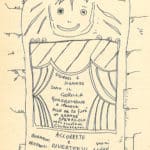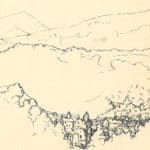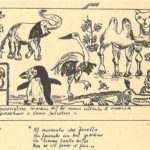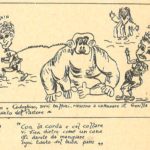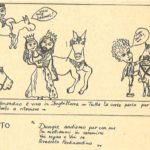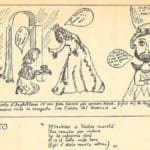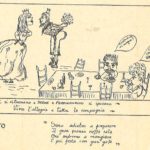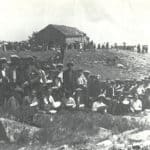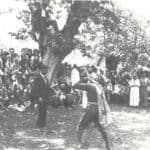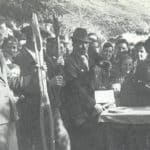Il Gorilla Quadrumàno. 1974.
from stable theater to long-lasting actions in the mountains of the Emilian Apennines and beyond, to the World Theater Festival of Nancy
by Giuliano Scabia
with students of dramaturgy from the University of Bologna, 1974-75
main actions:
party of the Gorilla Quadrumàno in Novi di Modena;
Resurrection of the brigand Musolino on the field of Acqualagna;
Visit of the Gorilla Quadrumàno to the territories of the Upper Apennines of Reggio Emilia;
Visit of the Gorilla Quadrumàno to the city of Pesaro with an attempt to capture and release it with fire;
Journey of the Gorilla Quadrumàno in the petrochemical territory;
The Gorilla Quadrumàno goes to Fermo to present the bandit Musolino and pose the problem of true history;
Christmas tour of the Gorilla Quadrumàno on the Reggio Emilia Apennines;
The Gorilla Quadrumàno inaugurates the Bologna Modern Art Gallery in the Pillar District;
Grand Comedie du Gorilla Quadrumàno dans le bassin de Longwy et a Nancy;
Theatrical descent of the Po (in collaboration with the Venice Biennale and the regions of Lombardy, Emilia and Veneto).
Attenti al Gorilla
by Marco Belpoliti
[…] When in 1972 he was asked to teach at the University of Bologna, in the Dramaturgy program, Scabia was at the height of an experience that in three to four years had profoundly changed his career as author and theater director. He had distanced himself from official institutions (theaters, festivals). His first workshop with DAMS students in the 1972-73 academic year was devoted to Theater and information, and was subtitled Experience of counter-intelligence in the streets of Bologna. The students, using as materials cartons and other items, created in the city’s streets a theater-newspaper devoted to the Watergate scandal, an example of the kind of improvisations that became common four years later during the 1977 movement. 1978 saw the start of the Gorilla Quadrumàno adventure, certainly the best known of those that Scabia directed with his university students. The idea was came from Remo Melloni, a student of Poviglio, a town in the province of Reggio Emilia. Remo found some theater scripts written in the early 20th century and used by farmers for performances in their stables. At first the group Scabia coordinated studied the linguistic and dramaturgic aspects of this “barn theater,” then chose to stage one of the texts during the university course. Their research at once spread to the topic of popular and rural culture, which became, at least for a period of the course, a true field of research. Scabia was sensitive not only to the theatrical content of the rediscovered texts but also and especially to their social value, or better, to the kind of society that these writings presupposed and simultaneously prefigured. Rural culture was therefore not a subject of dry, neutral study but a past-present context with which to establish not only ideal links and relationships. In the theater that Scabia and his students were staging, the concept of ‘subaltern culture” was absent, since this theater was first of all an investigation into “present-day society, the kind of sociability which forms around a text like Il Gorilla quadrumàno.
After a month the group officially adopted the name of Gorilla quadrumàno, taken from one of the discovered texts. These were a kind of verse “comedies” (rhythmic quatrains) called “farces or” rhymes” (the farces were written in dialect, the rhymes both in dialect and in Italian, depending on whether they were talking about masters or servants).
The Gorilla represented the Wild Man that appears in carnival rituals, where he was a prey to be hunted, captured and derided. His image, as emphasized in the book that gathered the materials of this experience, was far from negative. If at first the Gorilla was presented as a dreadful monster – he was, according to Propp, the missing magic object – he was soon transformed into a magical helper and donor. Scabia and his students, who had traced his morphological vicissitudes in the early 20th century pages of Ferdinando Neri as well as in Italo Calvino’s Fiabe italiane, dated them from as far back as the brothers Grimm, identifying the hidden meanings that could be useful for a theatrical creation (here we speak of theater, although it was clearly a theater that rejected the classic theatrical space and ventured into streets, country lanes, woods and valleys). And even this experience of Scabia’s, as the book published by Feltrinelli demonstrates, contained the story of their research, which presented itself as an initiation into the very essence of theater.
Documents are published in original language. In case the translation is present, both the original and the translation are published.
Some places visited by the Gorilla
Vaglie, Succiso, Novi di Modena
by Giuliano Scabia, in Gruppo di Drammaturgia 2 dell'Università di Bologna, Il Gorilla Quadrumàno, Feltrinelli, Milano 1974, p. 48, p. 84, p. 131.
Giuliano Scabia, Il Gorilla Quadrumàno, in Il Gorilla Quadrumàno, Feltrinelli, Milan 1974.
Giuliano Scabia, Fare teatro / fare scuola, in Gruppo di Drammaturgia 2 dell'Università di Bologna, Il Gorilla Quadrumàno, Feltrinelli, Milan 1974.
Gruppo di Drammaturgia 2 dell'Università di Bologna, La storia del Gorilla Quadrumàno e altre commedie in rima, in Il Gorilla Quadrumàno, Feltrinelli, Milan 1974.
Gruppo di Drammaturgia 2 dell'Università di Bologna, Morro Reatino, in Il Gorilla Quadrumàno, Feltrinelli, Milan 1974.
Gruppo di Drammaturgia 2 dell'Università di Bologna, Nota alla scrittura, in Il Gorilla Quadrumàno, Feltrinelli, Milan 1974.
Gruppo di Drammaturgia 2 dell'Università di Bologna, Nota sui modi di comunicare, in Il Gorilla Quadrumàno, Feltrinelli, Milan 1974.
Images of the Gorilla Quadrumàno, by Giuliano Scabia and Andrea Landuzzi
Produced by the Chair of Dramaturgy 2, Department of Music and Entertainment, University of Bologna, 1985
Giovanni Celati, Le virtù del gorilla quadrumàno, «Rinascita», August 9, 1974.
Tullio De Mauro, Il gorilla fra la gente, «Paese sera», January 3, 1975.
Franco Cordelli, Brigante calabrese per «comunicare» col teatro di stalla, «Paese sera», November 21, 1974.
Massimo Marino, Il Gorilla Quadrumàno e i suoi viaggi, in Fernando Marchiori edited by). Il Teatro Vagante di GIuliano Scabia, Ubulibri, MIlan 2005
Antonio Costa, La voce di chi dice la parola, in Fernando Marchiori edited by). Il Teatro Vagante di GIuliano Scabia, Ubulibri, MIlan 2005
Fernando Marchiori, Messa in scena dei conflitti, in Il Teatro Vagante di GIuliano Scabia, Ubulibri, MIlan 2005
56/5000 The videos of the Gorilla Quadrumàno. Curated by Massimo Marino, taken from the special edited by Massimo Marino and dedicated to Giuliano Scabia's eighty years. Four videos are presented, filmed and edited at very different times. In addition to the first, which is summarized, there are the interventions of the Gorilla in Mira, in a district of Bologna, at the Nancy International Theater Festival.
The footsteps of the Gorilla, taken from the special edited by Massimo Marino and dedicated to Giuliano Scabia's eighty years. In this case the story of Massimo Marino is accompanied by the images of Enrico Scuro.

